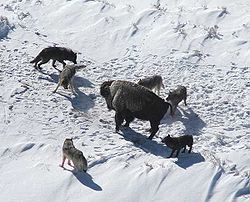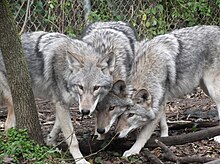Pack (canine)


A pack is a social group of conspecific canines. The number of members in a pack and their social behavior varies from species to species. Social structure is very important in a pack. Canine packs are led by a breeding pair, consisting of the alpha male and alpha female.
Pack behaviour in specific species
Gray wolves (Canis lupus) usually live in packs that consist of adult parents and their offspring of perhaps the last two or three years. The adult parents are usually unrelated and other unrelated wolves may sometimes join the pack.[2] Wolves usually hunt in packs, but they hunt alone in the spring and summer months when plenty of prey is available. They are found in both Eurasia and North America.
Black-backed jackals (Canis mesomelas) in Southern and Eastern Africa and coyotes (Canis latrans) in North America have a single long-term mate. As such, they usually hunt alone or in pairs.[3][4] A pack consists of the breeding pair and their current young. They occasionally cooperate in larger packs to hunt big game, but rarely hunt animals larger than a small, young antelope. Black-backed jackals are not typically considered 'aggressive' towards larger animals but tend to be wary of humans. However, they will become aggressive if they feel threatened, to defend the boundaries of their territories.
The Ethiopian wolf (Canis simensis) pack members hunt for rodents alone and come together mainly to defend their territory from rival packs.[5]
Corsac foxes sometimes form packs, unlike some other fox species.[6]
Pack behaviour in gray wolves
This section has multiple issues. Please help improve it or discuss these issues on the talk page. (Learn how and when to remove these template messages)
|
Wolves are known for forming affiliative bonds within the pack hierarchy.[7] Wolves in packs are known for "play-fighting" with one another,[7] perhaps as a reflection of the relationships present in the pack, reflecting any tension, cooperation, and competition present.[7] Tensions are noted to become higher around breeding season. This is due to increased opportunities for reproduction. Individuals challenge the group hierarchy to gain better-quality mates. This leads to greater intraspecific competition and rising tensions.[7] Female wolves are known for being the main initiators of affiliative interactions, though a small percentage of males will initiate affiliative interactions.[7] The omega male is not a target of any affiliative interaction.[7] In other studies, researchers have separated the most dominant wolf from the most subordinate wolves.[8] It was recorded that the dominant wolf spent less time sleeping and showed more behavioural stress compared to the omega wolf.[8] The dominant wolf was reported to rest in the section of his enclosure closest to his pack.[8] Furthermore, researchers noted that younger, more subordinate wolves appear to have less attachment to their pack compared to their higher-ranking compatriots.[8]
Cooperation is essential for tasks such as hunting and protecting the young, though the level of attachment present in the pack is not necessarily equal.[8] The majority of wolves are known for dispersing from their birth pack; this makes measuring attachment behavior within the packs difficult.[9] There are cases in which wolves leave their pack, typically when accompanying siblings of the same sex.[9] This behaviour is suggested to be adaptive, which will benefit pack mates in future conflicts.[9]
All individuals benefit from being a member of the wolf pack; the weak are supported by the efforts of stronger wolves,[10][11] and higher-ranking individuals enjoy better and larger kills than could be taken on their own.[12] Protection is granted by sheer number, and larger, more plentiful territory can be won and sustained.[13] Care and protection of the young are shared, and knowledge can be passed down through generations, creating a unique culture within each group[10]
The pack is typically a nuclear family unit.[14] It often consists of 5–10 (though in areas of high prey abundance can be up to 30)[15] mostly related individuals, specifically consisting of a typically unrelated breeding pair also known as the alphas,[16] their offspring, and occasionally a handful of other wolves which can be related or not.[14] Membership may be fluid and is subject to change.[17] Outside wolves may be shunned or, more rarely, accepted, depending on the specific circumstances. Genetic variability can become limited within such an interrelated group, and so conditions for gene flow must exist.[16] Outside wolves can provide these opportunities.[10] A pack may accept another wolf into their group if it is a distant relative,[14] if reproduction rates are low due to the loss or infertility of an alpha, or if their numbers are significantly reduced.[16][failed verification]
Characterisation of wolves into dominance hierarchies of alpha, beta, and omega was based on behavioural studies of unrelated wolves in captivity, and this assemblage largely does not apply to natural wolf packs, which are familial units.[14]
Wolves without packs
The breeding pair ("alphas")
Within the wolf pack, the breeding pair or the dominant breeding pair (in packs with multiple breeders), often referred to in familiar language as the "alpha pair" or the "alpha wolves", are typically the members of the family unit which breed and produce offspring; they are the matriarch and patriarch of the family.[15] It was previously believed to be common for an aging or sick alpha to be replaced by one of their offspring,[16] but more recent studies have shown this incestuous behaviour to be very rare.[18]
The pups

The importance of the alpha is rivalled only by that of the pups.
Dominance and the "alpha wolf"

Animals that typically predominate over others are associated with the term alpha. Among pack-living wolves, alpha wolves are the genetic parents of most cubs in the pack. Such access to mating females creates strong selective pressure for intra-sex competition.[21]
Wolves show deference to the alpha pair in their pack by allowing them to allocate the distribution of food, typically preferentially feeding the youngest wolves. Wolves use
In the case of other wild canids, the alpha male may not have exclusive access to the alpha female;
As dominant roles may be deemed normal among social species with extended parenting, it has been suggested that the additional term alpha is not required merely to describe dominance due to its ubiquity but should be reserved for where they are the predominant pack progenitor. For instance, wolf biologist L. David Mech stated:[14]
...calling a wolf an alpha is usually no more appropriate than referring to a human parent or a doe deer as an alpha. Any parent is dominant to its young offspring, so alpha adds no information. Why not refer to an alpha female as the female parent, the breeding female, the matriarch, or simply the mother? Such a designation emphasizes not the animal's dominant status, which is trivial information, but its role as pack progenitor, which is critical information. The one use we may still want to reserve for alpha is in the relatively few large wolf packs comprised of multiple litters. ... In such cases, the older breeders are probably dominant to the younger breeders and perhaps can more appropriately be called the alphas. ... The point here is not so much the terminology but what the terminology falsely implies: a rigid, force-based dominance hierarchy.
Use in dog training
The term alpha was popularised as early as 1976 in the dog training book How to Be Your Dog's Best Friend (Monks of New Skete), which introduced the idea of the alpha roll, a technique for punishing unwanted dog behaviours. Psychologist and dog trainer Stanley Coren wrote in the 2001 book How to Speak Dog, "You are the alpha dog... You must communicate that you are the pack leader and dominant".[28]
It has been suggested that the use of such techniques may have more to do with human psychology than with dog behavior; "dominance hierarchies and dominance disputes and testing are a fundamental characteristic of all social groups... But perhaps only we humans learn to use punishment primarily to gain for ourselves the reward of being dominant.[29]
Most leading veterinary and animal behaviour associations and most contemporary trainers would agree to advocate the use of rewards to teach commands and encourage good communication between owners and their pets. Many modern practices dictate the abandonment of outdated "pack" methods.
See also
References
- ^ Animal Diversity Web. "Lycaon pictus: Information". University of Michigan. Retrieved 21 April 2008.
- ^ a b L. David Mech PP. "Schenkel's Classic Wolf Behavior Study Available in English". Archived from the original on 10 August 2013. Retrieved 21 April 2008.
...Schenkel's 1947 "Expressions Studies on Wolves", the study that gave rise to the now outmoded notion of alpha wolves. That concept was based on the old idea that wolves fight within a pack to gain dominance and that the winner is the "alpha" wolf. Today we understand that most wolf packs consist of a pair of adults called "parents" or "breeders," and their offspring.
- ^ Animal Diversity Web. "Canis mesomelas: Information". University of Michigan. Retrieved 21 April 2008.
- ^ "Coyotes 101 – CoyoteSmart". www.coyotesmarts.org. Retrieved 14 April 2018.
- ^ "Ethiopian Wolf". Animal Info. 2005-03-07. Retrieved 2015-02-26.
- doi:10.1644/832.1.
- ^ doi:10.1139/z03-159.
- ^ .
- ^ S2CID 3894642.
- ^ a b c d e "The Social Wolf". Living with Wolves. Retrieved February 20, 2019.
- ^ "The wolf and the wolf pack: a perfect mechanism of social organisation". blog.almonature.com. 2015-07-07. Retrieved 2023-09-21.
- S2CID 3175156.
- ^ "Pack power". The Economist. March 30, 2015. Archived from the original on 1 January 2021.
- ^ doi:10.1139/z99-099. Archived from the original on 2004-12-21. Retrieved March 17, 2019.
The point here is not so much the terminology but what the terminology falsely implies: a rigid, force-based dominance hierarchy.
PDF available at wolf.org - ^ a b "Gray Wolf Biology & Behavior". Western Wildlife Outreach. Retrieved February 24, 2019.
- ^ obsolete source]
- ^ "Wolf FAQs & Answers". International Wolf Center. 17 May 2013. Retrieved March 2, 2019.
- .
- ISBN 978-0307464705.
- ^ Smith, Doug (March 5, 2015). "Wolf pup survival a fragile thing". Star Tribune. Archived from the original on 27 August 2021. Retrieved March 27, 2019.
- S2CID 43709256– via JSTOR.
- ISBN 978-0743400480.
- obsolete source]
- ^ C. Michael Hogan. 2009[full citation needed]
- ISBN 9780691176932.
- ^ "ClickerSolutions Training Articles - The History and Misconceptions of Dominance Theory". Clickersolutions.com. Retrieved 2015-02-26.
- doi:10.1139/z99-099. Archived from the originalon 14 December 2005.
- ISBN 0-684-86534-3.
- ISBN 0-553-38039-7.
- ^ "Position Statement on the Use of Dominance Theory in Behavior Modification of Animals" (PDF). American Veterinary Society of Animal Behavior. Retrieved 17 February 2021.
- ^ "Dog behaviour pack leaders debunked". Affinity Dog Training. Retrieved 2013-08-16.
